 W
WCypriot cuisine is the culinary traditions and practices originating from Cyprus. It is heavily influenced by Arab, Greek and Turkish cuisines, whilst also sharing similarities with the cuisines of Italy and France
 W
WAfelia is a traditional Cypriot pork dish. It is pork marinated and cooked in red wine with coarsely crushed coriander seed. In order to prepare the dish, ingredients like salt, pepper, oil etc. are included. During the British era the use of butter instead of oil was noted. Afelia is usually served with potato dish, bulgur and yogurt.
 W
WAvgolemono or egg–lemon is a family of sauces and soups made with egg yolk and lemon juice mixed with broth, heated until they thicken. They are found in Greek, Arab, Sephardic Jewish, Turkish, Balkan and Jewish-Italian cuisine.
 W
WDoogh, dhallë, ayran or tan is a cold savory yogurt-based beverage, popular across Western Asia, Central Asia, South Asia, Southeastern Europe and Eastern Europe. The principal ingredients are yogurt, water and salt. Herbs such as mint may be optionally added. Some varieties are carbonated.
 W
WBorek or burek is a filled pastry made of a thin flaky dough such as filo with a variety of fillings, such as meat, cheese, spinach or potatoes. Boreks are mainly associated with the areas of the former Ottoman Empire, including the Balkans and the Caucasus, the Middle East, Eastern European and Central European countries, Northern Africa and Central Asia. A borek may be prepared in a large pan and cut into portions after baking, or as individual pastries. They are usually baked but some varieties can be fried. Borek is sometimes sprinkled with sesame or nigella seeds, and they may be served hot or cold.
 W
WCyprus brandy is a variety of brandy made on the Mediterranean island of Cyprus.
 W
WThe brandy sour is a mixed alcoholic cocktail considered the unofficial national cocktail of Cyprus. While other forms of the brandy sour cocktail exist, the Cypriot variety is a distinct mixture, which only shares the basic brandy and lemon flavourings with other variants. Both brandy and lemons are among Cyprus's major exports, and both have distinctive Cypriot characteristics.
 W
WBulgur (from Turkish: bulgur itself from is a cereal food made from the cracked parboiled groats of several different wheat species, most often from durum wheat. It originates in Middle Eastern cuisine.
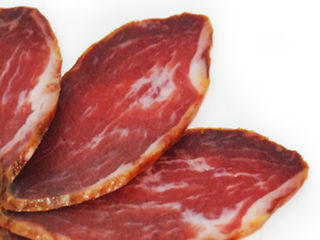 W
WCured pork tenderloin is found in various cuisines in Mediterranean Europe and South America. It is typically salted or brined then dry-cured or smoked.
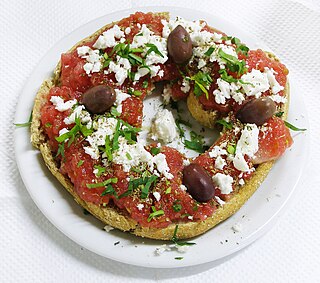 W
WDakos or ntakos, also known as koukouvagia or koukouvayia or—in eastern Crete—kouloukopsomo (from koulouki + psomi, pup + bread, allegedly the bread given to puppies), is a Cretan meze consisting of a slice of soaked dried bread or barley rusk (paximadi) topped with chopped tomatoes and crumbled feta or mizithra cheese, and flavored with herbs such as dried oregano. Olives and pepper can also be added.
 W
WDaktyla is a leavened 'country' or 'village' bread from Greece, but also popular in Cyprus and Turkey.
 W
WMany cuisines feature eggplant salads and appetizers.
 W
WFasolada or fasoulada is a Greek, Mediterranean, and Cypriot soup of dry white beans, olive oil, and vegetables. It is sometimes called the "national food of the Greeks".
 W
WFatayer, Petaeer is a meat pie that can alternatively be stuffed with spinach, or cheese such as Feta or Akkawi. It is part of Levantine cuisine and is eaten in Iraq, Iran, Syria, Egypt, Lebanon, Palestine, Kuwait, Saudi Arabia, Jordan and Israel. In Argentina, fatayer are also popular as a variety of empanada, called empanada árabe.
 W
WFlaouna, , is a cheese-filled pastry from the island of Cyprus, which may include raisins or be garnished with sesame seeds. Flaounes are traditionally prepared for Easter by Orthodox Cypriots Regional names for flaouna include vlaouna, fesoudki (Greek:φεσούδκι) in Karavas, and aflaouna in Karpasia. It is served at Ramadan by Turkish Cypriots.
 W
WGalaktoboureko is a Greek, Turkish, and Syrian dessert of semolina custard baked in filo. Turkish Laz böreği is made with a type of pudding called muhallebi instead of semolina custard. It is popular in Rize and Artvin provinces in the Black Sea Region, home of many Laz people.
 W
WGreek salad or horiatiki salad is a popular salad in Greek cuisine generally made with pieces of tomatoes, cucumbers, onion, feta cheese, and olives and dressed with salt, pepper, Greek oregano, and olive oil. Common additions include green bell pepper slices or caper berries. Greek salad is often imagined as a farmer's breakfast or lunch, as its ingredients resemble those that a Greek farmer might have on hand.
 W
WHalloumi or haloumi is a semi-hard, unripened cheese made from a mixture of goat's and sheep's milk, and sometimes also cow's milk. It has a high melting point and so can easily be fried or grilled, a property that makes it a popular meat substitute. Rennet is used to curdle the milk in halloumi production, although no acid-producing bacteria are used in its preparation.
 W
WHalloumoti / Hellimli is a Cypriot savoury pastry made with halloumi cheese.
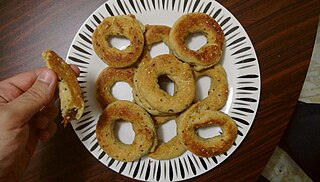 W
WKa'ak or kahqa is the common Arabic word for biscuit, and can refer to several different types of baked goods produced throughout the Arab world and the Near East. The bread, in Middle Eastern countries, is similar to a dry and hardened biscuit and mostly ring-shaped. This pastry is popular in Indonesia, and called as "kue kaak".
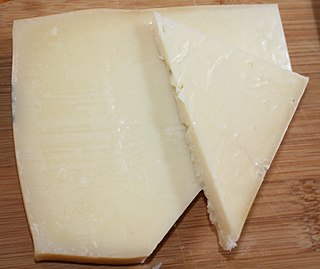 W
WKefalotyri or kefalotiri is a hard, salty white cheese made from sheep milk or goat's milk in Greece and Cyprus. A similar cheese Kefalograviera, also made from sheep or goat milk, is sometimes sold outside Greece and Cyprus as Kefalotyri. Depending on the mixture of milk used in the process the color can vary between yellow and white.
 W
WKibbeh is a family of dishes based on spiced ground meat, onions, and grain, popular in Middle Eastern cuisine.
 W
WLapa (Turkish) or lapas is a kind of rice porridge or gruel eaten in the Balkans, Levant, and Middle East. It is made of just rice, water, and salt and has the consistency of a thick soup.
 W
WLazarákia are small, sweet spice breads made in Greece and Cyprus by Orthodox Christians on Lazarus Saturday, the Saturday that begins Holy Week. They are eaten to celebrate the miracle of Jesus raising Lazarus from the dead. They are shaped like a man wrapped in a shroud, supposedly Saint Lazarus of Bethany, with cloves for eyes. They contain several sweet spices and are a fasting Lenten food, meaning that they do not contain any dairy products or eggs. For that reason, unlike the tsourekia, they are brushed with olive oil instead of egg or butter for a gloss finish.
 W
WLoukaniko is a type of Greek sausage made from pork or lamb and typically flavored with orange peel, fennel seed, and various other dried herbs and seeds, and sometimes smoked over aromatic woods. They are also often flavored with greens, especially leeks.
 W
WMahleb or Mahalepi is an aromatic spice made from the seeds of a species of cherry, Prunus mahaleb. The cherry stones are cracked to extract the seed kernel, which is about 5 mm diameter, soft and chewy on extraction. The seed kernel is ground to a powder before use. Its flavour is similar to a combination of bitter almond and cherry, and similar also to marzipan.
 W
WThe melomakarono is an egg-shaped Greek dessert made mainly from flour, olive oil, and honey. Along with the kourabies it is a traditional dessert prepared primarily during the Christmas holiday season.
 W
WMuhallebi is a milk pudding commonly made with rice, sugar, milk and either rice flour, starch or semolina, popular as a dessert in the Middle East. The dessert is called Muhallebi in Turkey, but the Egyptian variant is called Mahalabia. Where as in Lebanon, Syria and Iraq, it is called Malabi.
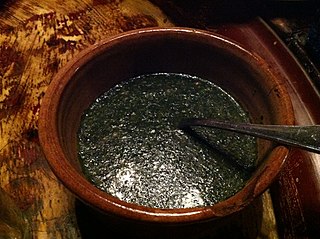 W
WMulukhiyah, molokheyya, molokhia or mulukhiyyah is the leaves of Corchorus olitorius, commonly known in English as denje'c'jute, nalta jute, tossa jute, jute mallow'. It is used as a vegetable. It is popular in Middle East, East African, west African and North African countries and is called “Saluyot” in the Philippines. Mulukhiyah is rather bitter, and when boiled, the resulting liquid is a thick, highly mucilaginous broth; it is often described as "slimy", rather like cooked okra. Mulukhiyah is generally eaten cooked, not raw, and is most frequently turned into a kind of soup or stew, typically bearing the same name as the vegetable in the local language. Traditionally mulukhiyah is cooked with chicken or at least chicken stock for flavor and is served with white rice, accompanied with lemon or lime.
 W
WNettle soup is a traditional soup prepared from stinging nettles. Nettle soup is eaten mainly during spring and early summer, when young nettle buds are collected. Today, nettle soup is mostly eaten in Scandinavia, Iran, Ireland, and Eastern Europe, with regional differences in recipe; however historically consumption of nettles was more widespread.
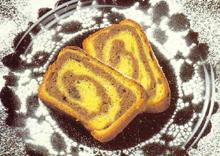 W
WA nut roll is a pastry consisting of a sweet yeast dough that is rolled out very thin, spread with a nut paste made from ground nuts and a sweetener like honey, then rolled up into a log shape. This 'log' is either left long and straight or is often bent into a horseshoe shape, egg washed, baked, and then sliced crosswise. Nut rolls resemble a jelly roll but usually with more layers of dough and filling, and resemble strudels but with fewer and less delicate dough layers. Fillings commonly have as their main ingredient ground walnuts or poppy seeds.
 W
WOrgeat syrup is a sweet syrup made from almonds, sugar, and rose water or orange flower water. It was originally made with a barley-almond blend. It has a pronounced almond taste and is used to flavor many cocktails. Orgeat syrup is an important ingredient in the Mai Tai and many Tiki drinks.
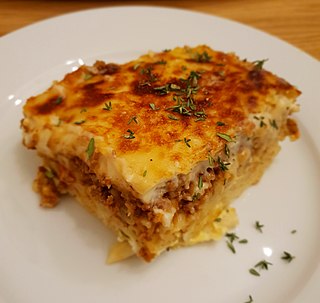 W
WPastitsio is a Greek baked pasta dish with ground meat and béchamel sauce, with variations of the dish found in other countries of the Mediterranean Sea.
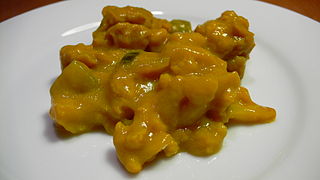 W
WPiccalilli, or mustard pickle, is a British interpretation of South Asian pickles, a relish of chopped and pickled vegetables and spices. Regional recipes vary considerably.
 W
WRavioli are a type of pasta comprising a filling enveloped in thin pasta dough. Usually served in broth or with a sauce, they originated as a traditional food in Italian cuisine. Ravioli are commonly square, though other forms are also used, including circular and semi-circular (mezzelune).
 W
WSheftalia is a traditional Cypriot food. It is a type of crépinette, a sausage without skin, that uses caul fat, or omentum, the membrane that surrounds the stomach of pig or lamb, to wrap the ingredients rather than sausage casing. It is a traditional Cypriot dish.
 W
WSkordalia or skordhalia or skorthalia, is a thick purée in Greek cuisine traditionally made by combining crushed garlic with a bulky base —which may be a purée of potatoes, walnuts, almonds or liquid-soaked stale bread—and then beating olive oil in to make a smooth emulsion, to which some vinegar is added.
 W
WSouvla is a popular dish from Cyprus. It consists of large pieces of meat cooked on a long skewer over a charcoal barbecue.
 W
WSouvlaki, is a popular Greek fast food consisting of small pieces of meat and sometimes vegetables grilled on a skewer. It is usually eaten straight off the skewer while still hot. It can be served with or inside of a rolled pita, typically with lemon, sauces, vegetables such as sliced tomato and onion, and fried potatoes as a side. The meat usually used in Greek and Cyprus is pork, although chicken, beef, and lamb may also be used there and elsewhere.
 W
WSpoon sweets are sweet preserves, served in a spoon as a gesture of hospitality in Albania, Greece, Cyprus, the Balkans, parts of the Middle East, and Russia. They can be made from almost any fruit, though sour and bitter fruits are especially prized. There are also spoon sweets produced without fruit.
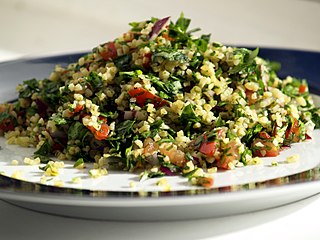 W
WTabbouleh is a Levantine salad made mostly of finely chopped parsley, with tomatoes, mint, onion, bulgur, and seasoned with olive oil, lemon juice, salt and sweet pepper. Some variations add lettuce, or use semolina instead of bulgur.
 W
WTahini or tahina is a Middle Eastern condiment made from toasted ground hulled sesame. It is served by itself or as a major ingredient in hummus, baba ghanoush, and halva.
 W
WA tahini roll or tahini bread roll is a sweet pastry found commonly in the cuisines of Armenia as Թահինով Հաց; Cyprus and Greece as ταχινόπιττα or τασιηνόπιττα; Turkey as tahinli çörek; and in Arab cuisine as khubz tahini. They are a popular street food in Cyprus.
 W
WA tajine or tagine is a Berber dish, named after the earthenware pot in which it is cooked. It is also called maraq or marqa.
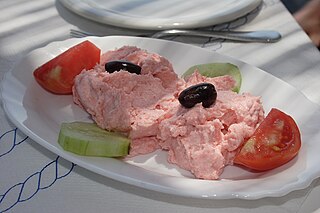 W
WTaramasalata or taramosalata is a meze made from tarama, the salted and cured roe of the cod, carp, or grey mullet (bottarga) mixed with olive oil, lemon juice, and a starchy base of bread or potatoes, or sometimes almonds. Variants may include garlic, spring onions, or peppers, or vinegar instead of lemon juice. While not traditionally Greek, smoked rather than cured cod's roe is more widely available in some places, and often used. Bottarga is usually much more expensive than cod's roe.
 W
WTarhana is a dried food ingredient, based on a fermented mixture of grain and yoghurt or fermented milk, found in the cuisines of Southeast Europe and the Middle East. Dry tarhana has a texture of coarse, uneven crumbs, and it is usually made into a thick soup with water, stock, or milk. As it is both acidic and low in moisture, the milk proteins keep for long periods. Tarhana is very similar to some kinds of kashk.
 W
WTiropita or tyropita is a Greek pastry made with layers of buttered phyllo and filled with a cheese-egg mixture. It is served either in an individual-size free-form wrapped shape, or as a larger pie that is portioned.
 W
WTsamarella is a traditional food and one of Cyprus' main lunch meats which is common in both Greek Cypriot and Turkish Cypriot communities.
 W
WTsoureki also known as شوريك (Arabic), choreg or "chorek", çörək (Azerbaijani), çyrek (Albanian), kozunak, cozonac (Romanian) or paskalya çöreği (Turkish) is a sweet holiday bread made with flour, milk, butter and sugar and commonly seasoned with orange zest, mastic resin or mahlab. One variation commonly called "Easter bread" is made by Greek communities during Easter, not only in Greece, but also in other countries with Greek communities. It is also sometimes called Armenian Easter bread.
 W
WTurkish delight or lokum is a family of confections based on a gel of starch and sugar. Premium varieties consist largely of chopped dates, pistachios, hazelnuts or walnuts bound by the gel; traditional varieties are often flavored with rosewater, mastic gum, bergamot orange, or lemon. The confection is often packaged and eaten in small cubes dusted with icing sugar, copra, or powdered cream of tartar to prevent clinging. Other common flavors include cinnamon and mint. In the production process, soapwort may be used as an emulsifying additive.
 W
WTzatziki, cacık, or tarator is a dip, soup, or sauce found in the cuisines of Southeast Europe and the Middle East. It is made of salted strained yogurt or diluted yogurt mixed with cucumbers, garlic, salt, olive oil, sometimes with vinegar or lemon juice, and herbs such as dill, mint, parsley and thyme. It is served as a cold appetizer (mezze), a side dish, and as a sauce for souvlaki and gyros sandwiches and other foods.
 W
WZivania or zivana is a Cypriot pomace brandy produced from the distillation of a mixture of grape pomace and local dry wines made from Xynisteri and Mavro grapes. The name of zivania is derived from zivana which means pomace in the Greek dialect of Cyprus. Zivania is colourless and alcoholic with a light aroma of raisins. Its alcohol content varies, with 45% by volume being the typical value. As defined by law, zivania shall not have more than 60% alcohol content. Zivania contains no sugars and has no acidity.